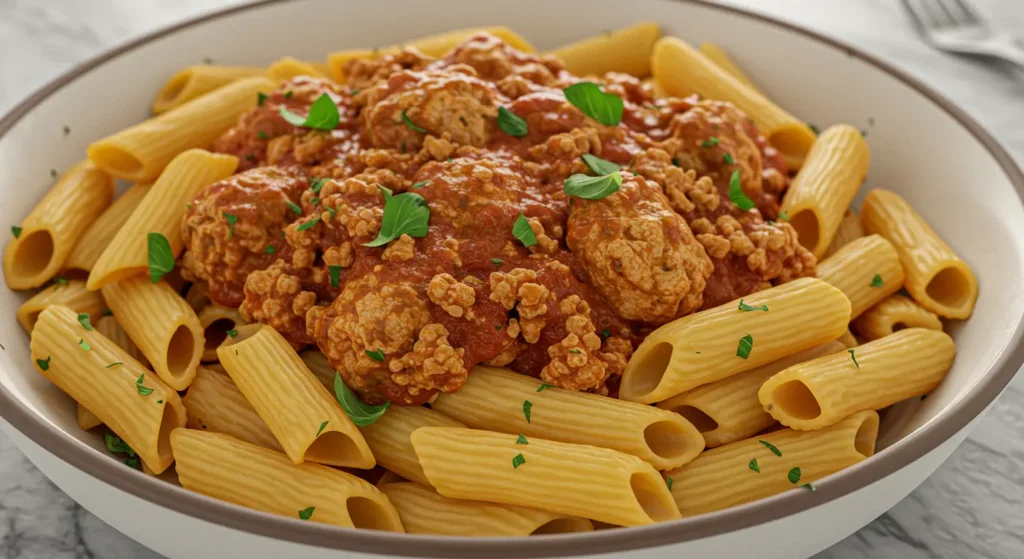Turkey Pasta – Why This Recipe?
As Chef Greeny, I’ve always believed that the most memorable meals come from simple ingredients transformed with love and creativity. My journey with turkey pasta began during my college years when I was searching for affordable, protein-packed meals that wouldn’t break my budget but would still satisfy my culinary curiosity.
What started as a necessity soon became a passion as I discovered how versatile and delicious turkey pasta dishes can be. The lean protein of turkey combined with the comforting embrace of pasta creates a perfect harmony that’s both nutritious and satisfying.
The recipe I’m sharing today has become a staple in my household, not just because it’s delicious, but because it’s adaptable to whatever ingredients you might have on hand. I’ve added my own twist with a blend of Mediterranean herbs and a splash of white wine that elevates this dish from everyday to extraordinary.
By the end of this post, you’ll learn how to create a turkey pasta dish that’s both wholesome and flavorful, with variations to suit different dietary needs and preferences. You’ll also discover the rich history behind this versatile dish and tips to make it your own family favorite.
Turkey Pasta – Ingredients and Preparation
Ingredients List

For the main turkey pasta dish (serves 4):
- 1 pound (450g) ground turkey
- 8 ounces (225g) pasta (penne, fusilli, or farfalle work well)
- 2 tablespoons olive oil
- 1 medium onion, finely chopped
- 3 cloves garlic, minced
- 1 red bell pepper, diced
- 1 carrot, finely diced
- 1 can (14.5 oz) diced tomatoes
- 2 tablespoons tomato paste
- 1/2 cup chicken broth
- 1/4 cup white wine (optional)
- 1 teaspoon dried oregano
- 1 teaspoon dried basil
- 1/2 teaspoon dried thyme
- 1/4 teaspoon red pepper flakes (adjust to taste)
- Salt and freshly ground black pepper to taste
- 1/4 cup fresh parsley, chopped
- 1/3 cup grated Parmesan cheese
Substitution options:
- Gluten-free: Use gluten-free pasta made from rice, corn, or legumes
- Dairy-free: Substitute nutritional yeast or dairy-free Parmesan alternative
- Lower carb: Use zucchini noodles or spaghetti squash instead of pasta
Step-by-Step Instructions
- Prepare your pasta: Bring a large pot of salted water to a boil. Cook pasta according to package instructions until al dente (usually 8-10 minutes). Reserve 1/2 cup of pasta water before draining. Tip: Adding plenty of salt to your pasta water (it should taste like seawater) is essential for properly seasoned pasta.
- Cook the turkey: While the pasta is cooking, heat 1 tablespoon of olive oil in a large skillet over medium-high heat. Add the ground turkey, breaking it apart with a wooden spoon. Season with salt and pepper. Cook until no longer pink, about 5-7 minutes. Tip: Don’t stir the turkey constantly—let it develop some browning for added flavor.
- Sauté the aromatics: Transfer the cooked turkey to a plate. In the same skillet, add the remaining tablespoon of olive oil. Add the onions and carrots, cooking until softened, about 4-5 minutes. Add the garlic and red bell pepper, cooking for another 2 minutes. Tip: If the bottom of the pan has browned bits from the turkey, don’t scrape them off—they’ll add flavor to your sauce.
- Create the sauce: Return the turkey to the skillet. Add the diced tomatoes, tomato paste, chicken broth, and white wine (if using). Stir in the dried herbs and red pepper flakes. Bring to a simmer and cook for 10-15 minutes, allowing the flavors to meld and the sauce to thicken slightly. Tip: If the sauce becomes too thick, add a splash of the reserved pasta water.
- Combine and finish: Add the drained pasta to the sauce, tossing to coat evenly. If needed, add a bit of the reserved pasta water to loosen the sauce. Remove from heat and stir in half of the chopped parsley. Tip: Adding the pasta directly to the sauce allows it to absorb the flavors better than simply topping pasta with sauce.
- Serve: Divide among serving plates or bowls. Top with grated Parmesan cheese and the remaining fresh parsley.
Notes and Tips
Storage: This turkey pasta dish will keep well in an airtight container in the refrigerator for up to 3-4 days. The flavors often become even more developed after a day in the fridge.
Reheating: When reheating, add a splash of water or broth to prevent the pasta from drying out. Heat gently on the stovetop or in the microwave.
Make-ahead options: You can prepare the turkey sauce up to 2 days in advance and store it separately from the pasta. When ready to serve, cook fresh pasta and combine with the reheated sauce.
Freezing: The sauce freezes beautifully for up to 3 months. Thaw overnight in the refrigerator before reheating and combining with freshly cooked pasta.
Serving suggestions: Pair this turkey pasta with a simple green salad dressed with lemon and olive oil, or some garlic bread for a complete meal.
Turkey Pasta – Nutritional Information
Nutrition Facts (Per Serving)
| Nutrient | Amount |
|---|---|
| Calories | ~425 |
| Carbohydrates | 45g |
| Protein | 28g |
| Total Fat | 15g |
| Saturated Fat | 4g |
| Unsaturated Fat | 9g |
| Trans Fat | 0g |
| Fiber | 4g |
| Sugar | 6g |
| Cholesterol | 65mg |
| Sodium | 320mg |
“This turkey pasta dish offers an excellent balance of lean protein and complex carbohydrates, making it a nutritionally complete meal that will keep you satisfied for hours.”
Turkey Pasta – History and Cultural Significance

Turkey pasta represents a beautiful fusion of American practicality and Italian culinary tradition. While pasta originated in Italy and has been a staple there for centuries, the pairing with turkey is a more modern innovation that showcases America’s love for adapting traditional recipes with locally available ingredients.
Turkey as a protein source gained popularity in American cuisine well beyond the Thanksgiving table during the latter half of the 20th century, as health-conscious consumers began seeking leaner alternatives to beef and pork. The lean profile of turkey meat made it an excellent choice for health-minded home cooks looking to create nutritious, protein-rich meals.
In Mediterranean cuisine, ground meats have long been paired with pasta—from classic Bolognese sauce to Greek pastitsio. The turkey pasta variation follows this tradition while offering a lighter alternative that doesn’t sacrifice flavor.
Regionally, you’ll find interesting variations on this theme. In the American Southwest, turkey pasta might include influences from Mexican cuisine with the addition of cumin, chili powder, and black beans. In the Northeast, a turkey pasta dish might incorporate cranberries or sage, echoing Thanksgiving flavor profiles. In Italy itself, you might find a similar dish called “pasta al tacchino,” often prepared with white wine, fresh herbs, and sometimes a touch of cream.
Turkey Pasta – Creative Variations
Mediterranean Turkey Pasta
Transform the basic recipe with these Mediterranean-inspired additions:
- Add 1/2 cup kalamata olives, pitted and halved
- Include 1/2 cup sun-dried tomatoes, chopped
- Mix in 1 cup fresh spinach during the final minutes of cooking
- Substitute feta cheese for Parmesan
- Add 1 teaspoon of dried oregano and a pinch of cinnamon
- Finish with fresh lemon zest and a squeeze of lemon juice
This variation emphasizes bright, tangy flavors that complement the mild turkey beautifully. The combination of olives and feta creates a salty counterpoint to the sweetness of the sun-dried tomatoes, while the spinach adds both nutrition and color.
Spicy Southwest Turkey Pasta
Give your turkey pasta a Southwestern twist with these modifications:
- Add 1 tablespoon chili powder and 1 teaspoon ground cumin to the turkey while cooking
- Include 1 diced jalapeño with the bell pepper (remove seeds for less heat)
- Mix in 1 cup corn kernels and 1 cup black beans (drained and rinsed)
- Top with avocado slices and cilantro instead of parsley
- Serve with a dollop of Greek yogurt or sour cream
- Add a squeeze of lime juice before serving
This hearty variation incorporates the bold flavors of Southwestern cuisine. The beans add extra protein and fiber, while the corn provides sweetness and texture. The avocado adds creaminess that balances the spices beautifully.
Turkey Pasta – Frequently Asked Questions

Can I freeze this turkey pasta dish?
You can freeze the turkey pasta sauce on its own for up to 3 months in an airtight container. However, I don’t recommend freezing the completed dish with pasta, as the texture of the pasta will deteriorate upon thawing and reheating. Instead, freeze just the sauce, then make fresh pasta when you’re ready to enjoy the meal again.
What can I substitute for ground turkey?
If you don’t have ground turkey available, you can substitute ground chicken, which has a similar mild flavor and lean profile. For a plant-based alternative, you could use crumbled tempeh or a plant-based ground meat substitute, though you may need to adjust the seasonings slightly as these alternatives sometimes need more flavor enhancement.
How long does it take to prepare this turkey pasta recipe?
The total preparation time is approximately 30-35 minutes, with about 10 minutes of prep work and 20-25 minutes of cooking time. If you’re short on time, you can chop vegetables in advance or use pre-chopped options from the grocery store.
Is turkey pasta healthy?
Yes, turkey pasta can be a very balanced meal when prepared with whole grain pasta and plenty of vegetables. Ground turkey is lower in fat than beef, providing lean protein while the pasta offers energy-sustaining carbohydrates. The vegetables add essential vitamins, minerals, and fiber. To make it even healthier, opt for whole wheat pasta and increase the vegetable-to-pasta ratio.
Can I make this dish spicier?
Absolutely! To increase the heat level, you can add more red pepper flakes, include a diced fresh chili pepper (such as jalapeño or serrano), or add a dash of hot sauce to the sauce. You can also serve the finished dish with hot sauce or crushed red pepper on the side, allowing each person to adjust the spice level to their preference.
Turkey Pasta – Final Thoughts
Turkey pasta represents the perfect intersection of nutrition, flavor, and convenience—exactly what modern home cooks are looking for in their weekly meal rotations. The lean protein from the turkey combined with the satisfying texture of pasta creates a meal that’s both comforting and energizing.
What makes this dish truly special is its versatility. Whether you stick with the classic recipe I’ve shared or experiment with one of the variations, you’re creating a foundation that can be adapted to your family’s tastes and dietary needs. The beauty of cooking lies in this flexibility—making a recipe your own.
I encourage you to try this turkey pasta recipe and make it part of your culinary repertoire. Play with the ingredients, adjust the seasonings to your taste, and don’t be afraid to get creative. Cooking should be an adventure, not a strict set of rules to follow.
As you become more comfortable with this dish, you might develop your own signature version that becomes a requested favorite at your dinner table. That’s the true joy of cooking—creating memories and traditions around food that nourishes both body and soul.
Leave a comment with your favorite variation or a photo of your turkey pasta creation! I’d love to see how you make this recipe your own.





2 thoughts on “10 Delicious Turkey Pasta Recipes That Will Transform Your Weeknight Dinners”